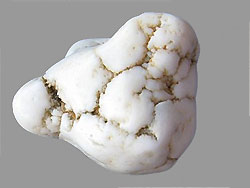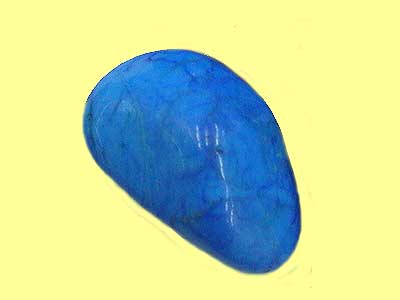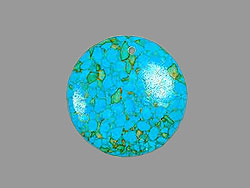A little help for buying turquoise gemstone beads

A little help for buying turquoise gemstone beads
Genuine turquoise is loved and it can be very expensive. At the same time no other gemstone is copied in so many kinds and sold as genuine turquoise. We show here a small overview of the available variants on the market of the real and the copied turquoise and would like to give greater safety when shopping.
Turquoise is a relatively rare copper-aluminum phosphate, and actually refers to a group of minerals, which, although having a similar structure but different compositions. This group includes Faustit , Chalkosiderit , Aheylit and Planerit .
High quality pure turquoise reach maximum hardness on the Mohs scale of 6 Less precious turquoises are porous and need to be fit for jewelry , be stabilized. This usually happens with resin , a resin , which collects under the action of heat in the stone and at the same time gives it a glossy finish. Mostly this is accompanied by a refreshing color. Due to the stabilized surface of any resulting jewelry is resistant to outside influences . Untreated turquoise is particularly sensitive to organic acids such as citric acid or acetic acid . It tolerates neither greater heat (from about 200 degrees Celsius is the stone removed from the water and it breaks ) or commercial jewelry bathrooms.
The color spectrum of turquoise ranges from white ( Chalk Turquoise ) through yellow and green to deep blue . The blue color is caused by idiochromatic copper during the green color is caused by the content of iron . Apart from the almost pure Sleeping Beauty Turquoise from Arizona most gems have a more or less strong grain - called matrix - which is caused by the shares of foreign rock.

Here you can see the different kinds of Turquoise and the copies:
Sleeping Beauty:
A high class Turquoise very low stone matrix. Its color is often referred to as "Persian Turquoise", an allusion to the high quality of the stone as it existed only in turquoise from Iranian mines. The Sleeping Beauty is named after the name of his mine, which is located in Arizona / USA. This Turquoise can be stabilized with the so-called "Zachery process." This method is known as "artificial interference" that was physically and chemically undetectable. Named this method is named after its inventor, James A. Zachery, who developed it in the 1980s. It is a type of electroplating with natural minerals that are normally present in turquoise and are introduced by means of electric current in the stone. This method is patented.

Genuine Turquoise:
under this name are gemstones combined of more or less good quality, which are almost invariably stabilized and usually pre coloured. Really good turquoises are gems that are traded on the market very high. Turquoises are produced mainly in the USA, Mexico, China, in the Sinai, in Iran and in southeastern Australia.


Chalk Turquoise:
This is the previously mentioned white turquoise. Its structure and composition corresponding to the real turquoise with one exception: it contains no copper and is therefore colorless. Chalk turquoise is dyed and stabilized accordingly for jewelery making. Since he often has an attractive matrix, it is suitable as the best substitute for the more expensive colored turquoise. Unfortunately, he is with his "real" relatives often sold as such, due to the similarity. A layman can hardly keep both apart. As a general rule most likely applies here: the more cheaper and relatively pristine, the beads are, the more likely it is Chalk turquoise.


Colored Magnesite:
Magnesite is similar to the Chalk Turquoise and is also sometimes traded as such. However, the stone is consists of an anhydrous carbonate and belongs to the group of Calcite. He was named the magnesium according to its metallic component. The same group, among other things includes the calcite and rhodochrosite. Magnesite is a Moh's hardness of 4 to 4.5 softer than the Chalk Turquoise and is unlike him, and the "real" turquoise fire resistant. Magnesite is used as a raw material for the manufacture of refractory bricks. Due to its attractive matrix in magnesite dyed and stabilized state is a good substitute for real turquoise.

Colored Howlite and Mountain-„Jade“:
Howlite belongs to the class of borates and is much rarer than magnesite. By nature he is white to beige and is often characterized by its similar matrix of the turquoise. He is blue, turquoise or green colored gladly sold as imitation turquoise. Overall, howlite is more expensive than magnesite, so that the Magnesitimitate are preferable to the howlite. Mountain "jade" is not jade but a dolomite marble, which, however, does not have the typical turquoise matrix. This stone is indeed often turquoise colored but less than "Turquoise" sold.

African Turquoise:
In this commercially "African Turquoise" called gemstone is a series kinds of Jaspis occurring in Africa that were colored accordingly. These beads are based on their pattern often very appealing.

Yellow Turquoise:
This stone gets its name from the fact that it is predominantly found and mined in turquoise mines. It has quartz and jaspis rock inside. It gives yellow turquoise both in its natural color ranging from pale yellow to mustard yellow with dark green inclusions as to whether or not colored.

Mosaic Turquoise:
This is a so-called composite stone. With the help of Resin smaller fragments of real or Chalk turquoise are composed. Mosaic Turquoise is a cheaper but very attractive stone.

Other Turquoise Imitations:
There are certainly quite a few more variants, but they play a rather minor role. However Widely used is a variant that is produced according to the principle of mosaic turquoise. Only small pieces but not only ground radicals, ie flour with turquoise resin are mixed in this case, colored and shaped. Another imitation one manufactures of glass. These pearls are often very pretty. One recognizes a glass imitation of the higher weight and the very regular black matrix.





